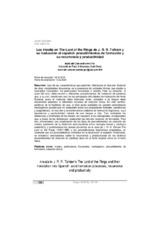Los irrealia en The Lord of the Rings de J. R. R. Tolkien y su traducción al español: procedimientos de formación y su recurrencia y productividad
Irrealia in J. R. R. Tolkien’s The Lord of the Rings and their translation into Spanish: word-formation processes, recurrence and productivity
Autor
Moreno Paz, María del Carmen
Editor
UCOPressFecha
2019Materia
IrrealiaParticulares ficcionales
Neologismo
Procedimiento de formación
Creación léxica
Fictional particulars
Neologism
Word formation process
Lexical creation
METS:
Mostrar el registro METSPREMIS:
Mostrar el registro PREMISMetadatos
Mostrar el registro completo del ítemResumen
Una de las características que permiten diferenciar el discurso ficcional de otras modalidades discursivas es la presencia de unidades léxicas que aluden a conceptos ficcionales: los particulares ficcionales o irrealia. Para su creación, el autor del texto debe recurrir a diferentes procedimientos de formación de palabras que, a su vez, constituyen una de las principales dificultades de traducción del texto ficcional, pues el traductor debe trasvasar estas unidades a la lengua meta recurriendo asimismo a diferentes recursos de creación léxica. En este sentido, partimos de la hipótesis de que, si bien estas unidades no pueden considerarse neologismos (puesto que no comparten todas sus propiedades formales, semánticas y pragmáticas), sí recurren a procedimientos similares de formación lingüística, cuya recurrencia y productividad variará de una lengua a otra. Tras contrastar las diferencias y similitudes de los irrealia con respecto a los neologismos, mostraremos que, a pesar de las diferencias, comparten los mismos recursos de formación. Para ello, ofreceremos una clasificación de los tipos de procedimientos de creación de irrealia (partiendo de la distinción estructuralista entre neología formal y neología semántica) y analizaremos los irrealia presentes en la obra de J. R. R. Tolkien The Lord of the Rings (1954-1955) y los procedimientos lingüísticos empleados, en contraste con los procedimientos utilizados en la traducción al español. Finalmente, se extraerán conclusiones sobre la recurrencia y productividad de los distintos procedimientos de creación de palabras tanto en el texto original como en el texto meta. One of the main characteristics that differentiate fictional discourse from other types of discourse is the existence of lexical units that name fictional concepts: fictional particulars or irrealia. To create them, the author of the text must use different word-formation processes which, in turn, constitute one of the main difficulties for the translation of fictional texts, since the translator must transfer these units to the target language also using different word-formation processes. In this sense, our hypothesis is based on the statement that, although these units cannot be considered as neologisms (since they do not share all their formal, semantic and pragmatic properties), they use the same word-formation processes for their creation, whose recurrence and productivity may vary from one language to another. Therefore, after establishing the differences and similarities of irrealia in relation to neologisms, this study aims to show that, in spite of the differences, the wordformation processes are the same in both cases. For this purpose, a classification of the types of word-formation processes for irrealia will be established, based on the structuralist distinction between formal and semantic neology. Secondly, an analysis of the irrealia from J. R. R. Tolkien’s The Lord of the Rings (1954-1955) will be carried out, in which a contrast will be made between the word-formation processes used in the source text and the translation into Spanish. Finally, conclusions will be drawn on the recurrence and productivity of the different word-formation processes for creating irrealia both in the source text and the target text.

